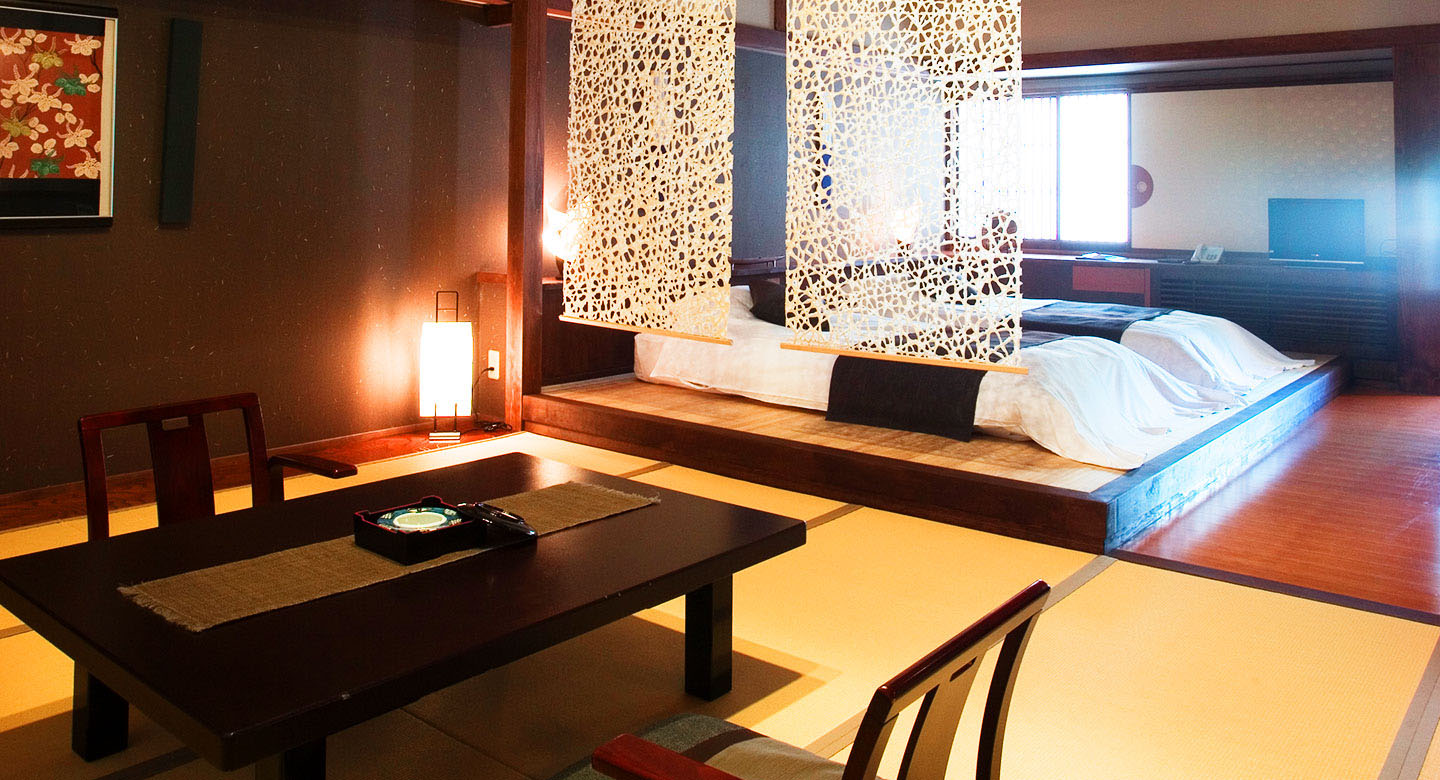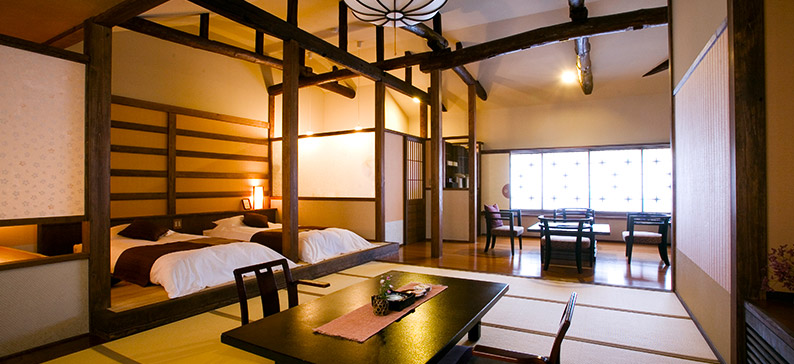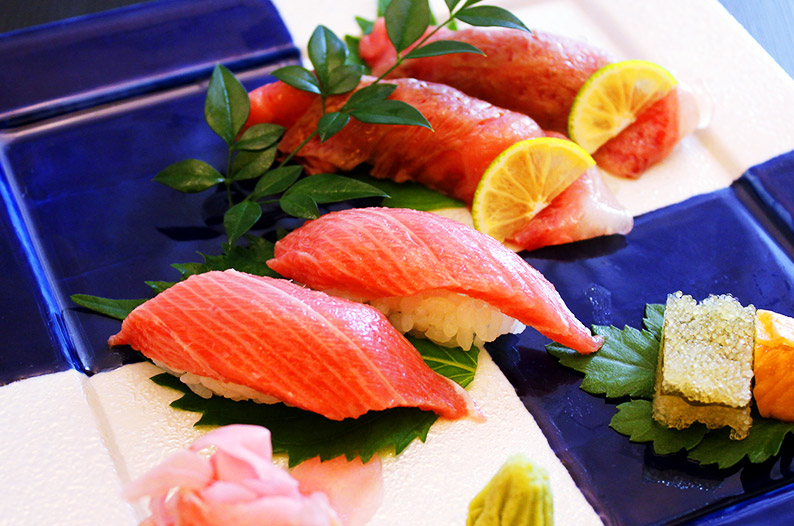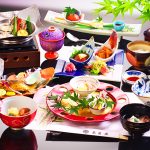Naraya
Tastefully elegant with its white walls and wooden architecture, Naraya beams with dignity and prestige. Founded in 1877, this Japanese-style inn is one of the oldest in the Kusatsu area, and stands in a league of its own.
GUNMA
The Shogun's Hot Spring
After a three-hour train ride from Tokyo, I set foot in Kusatsu, one of the Top 3 onsen (hot springs) in Japan. Walking through the town center, I’m confronted by the strong smell of sulfur wafting from the yubatake, or “hot spring field”. Avoiding the crowds around this main attraction, I dodge into a narrow alley. Within two minutes, I arrive in front of Naraya.
Tastefully elegant with its white walls and wooden architecture, Naraya beams with dignity and prestige. Founded in 1877 during the Meiji era, this ryokan (Japanese-style inn) is one of the oldest in the Kusatsu area, and stands in a league of its own. Brushing past long curtains carrying the family crest, my feet are greeted by the gentle touch of tatami as I enter a warm and welcoming space where the fragrance of wood and incense intermingle. The imposing woodwork and latticework on the reception desk give the illusion of having traveled through time to the samurai-ruled Edo period.
I’ve come to Naraya for its highly reputed onsen baths. Its location makes it the closest to the source in Kusatsu, meaning that the quality of the bathwater here is second to none. And Naraya’s unrivaled commitment to the quality of its bathwater makes it a secretly favored destination for onsen experts. At any given moment, two “bathwater keepers” are on shift to maintain ideal conditions. Checking every three hours, these keepers create the perfect temperature and ensure the silky texture of the bathwater, adjusting for the weather and other aspects on any given day.
Naraya has a unique way of conducting the hot spring water. Fifty-five degrees (Celsius) at the source, a natural slant is used to simultaneously transport and cool the hot spring water to 45 degrees. The hot spring water is then pooled into a special hut and allowed to rest. The bathwater keepers control the bathwater temperature to make it an ideal 42 degrees before it is poured into the communal bath. According to the bathwater keepers, this fine-tuning changes the texture and quality of the bathwater. In fact, the hot spring water in Kusatsu is known for its strong acidity, which irritates the skin. But the bathwater at Naraya is silky and melts as it touches your skin, and is elegant and mild compared to other ryokans using the same source. “I want to protect this heritage and pass it to the next generation,” says proprietress Kobayashi-san, expressing her unparalleled passion for Naraya’s hot spring water.
Kusatsu Hot Springs was discovered in 1197 by Minamoto-no-Yoritomo, politician and 12th century shogun. As he was hawk-hunting in the foothills of Mount Asama, he came across a mysterious boy who led him to the hot spring source. This boy was said to be the incarnation of Yakushi Nyorai, the medicine Buddha, thus giving Kusatsu Hot Springs the reputation of being a miracle source. Strongly acidic, the water here is effective for skin conditions, neuralgic pains, diabetes and external injuries.
Yoshimune, the 8th shogun of the Tokugawa dynasty, had the hot spring water from Naraya transported all the way to his Edo Castle in Tokyo. The “Shogun Bath” at Naraya is a large elliptical indoor bath with a regal atmosphere, whispering the history of this ryokan. Over the centuries, onsen amateurs have continued to visit Naraya to soak away their sorrows in this bath. Guests can also enjoy the “Bath of Perennial Youth and Longevity,” reputed to bring 1,000 years of life to bathers, the legend reinforced by the fact that the bath itself is carved from a 200-year-old pine.
Celebrating its 139th anniversary, Naraya was originally a small establishment built to accommodate 20 guests. While keeping the original wooden architecture, modern aspects have been incorporated to allow for maximum comfort within a traditional setting. Wandering down the hallways, guests are greeted by works of Noh artist Masataka Iizuka.
The dinner menu at Naraya is healthy but hearty, brimming with locally grown wild plants, Joshu beef hotpots and other culinary delights unique to the Kusatsu area. I get tipsy on a local sake called Kusatsu Melody. Rubbing my contented belly as I walk back to my room, I think of soaking one last time in the Shogun Bath before going to bed. But before I know it, I fall asleep on the fluffy futon, satiated to my heart’s content.
by Mari Kobayashi, translated by Maho Harada
April 30, 2016
Naraya information
Address
396 Kusatsu,Kusatsu-cho,Agatsuma-gun,Gunma-ken
+81 3 3839 9321
http://www.kusatsu-naraya.co.jp/
| Number of rooms | 35 |
|---|---|
| Internet | wifi available |
| Credit card | ok |
| Check in/out | in 2:00pm out11:00am |
| Language | Japanese only |
| Price range |
Additional Information about Naraya
Vegetarian option available
Recommended restaurants
Genji (izakaya) - 333-2 Kusatsushirane, Kusatsu-cho, Agatsuma-gun, Gunma-ken - TEL: 0279-88-7505
Ryuen (Chinese) - 116-2 Kusatsu, Kusatsu-cho, Agatsuma-gun, Gunma-ken - TEL: 0279-88-3777
Sanshiro (izakaya) - 114-2 Oazakusatsu, Kusatsu-cho, Agatsuma-gun, Gunma-ken - TEL: 0279-88-2032
Yurakutei (okonomiyaki) - 106-1 Kusatsu-cho, Agatsuma-gun, Gunma-ken - TEL: 0279-88-3001
Yama-Matagi & Umibanya (Japanese-style grill) - 478-3 Kusatsu, Agatsuma-gun, Gunma-ken - TEL: 0279-88-7515
Bar Choice (bar) - 23-1 Kusatsu, Kusatsu-cho, Agatsuma-gun, Gunma-ken - TEL: 0279-88-1414
A-Un-tei (izakaya) - 468-57 Kusatsu, Kusatu-cho, Agatsuma-gun, Gunma-ken - TEL: 0279-88-0306
Donguri (Japanese-style Western food) - 562-16 Kusatsu, Kusatsu-cho, Agatsuma-gun, Gunma-ken - TEL:0279-88-7222
Lucky Bagel (bagels) - 19-15 Kusatsu, Kusatsu-cho, Agatsuma-gun, Gunma-ken - TEL:0279-82-1004
Al Rododendro (Italian) - 557-11 Kusatsu, Kusatsu-cho,Agatsuma-gun, Gunma-ken - TEL:0279-88-6150
- TOPSTAYNaraya
- TOPDESTINATIONSGUNMANaraya




















